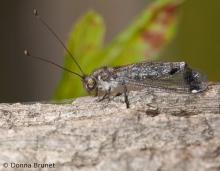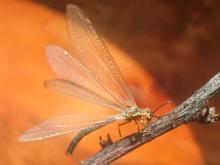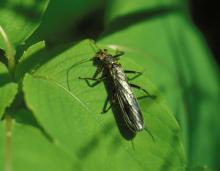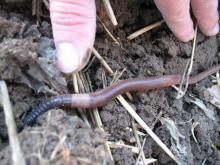Land Invertebrates
Media

Species Types
Scientific Name
More than 600 species in North America north of Mexico
Description
The mayflies are a fascinating group of insects. The nymphs live from months to years under water, and the delicate adults fly around in the air, mating, living for only a day or two.
Media

Species Types
Scientific Name
8 species in North America north of Mexico
Description
An owlfly looks like a dragonfly with a butterfly’s head. Dragonfly shaped and sized, they have long, clubbed antennae and large, bulging eyes. Look for them in summertime dusks and evenings.
Media

Species Types
Scientific Name
More than 100 species in North America north of Mexico
Description
Adult antlions look something like drab damselflies. These insects are most familiar in their immature stages, called doodlebugs, which create pits in sand for trapping ants.
Media

Species Types
Scientific Name
Nearly 700 species in North America north of Mexico
Description
Stoneflies have a lot in common with mayflies, caddisflies, dragonflies, and dobsonflies: They begin life as aquatic larvae, then molt and become winged adults. Many fish find stoneflies irresistible, and anglers know it.
Media

Species Types
Scientific Name
Scudderia furcata
Description
The fork-tailed bush katydid reaches about 1¾ inches long. It is usually leafy green and is most common in bushes, thickets, and other shrubby areas. It is most active after dusk. The call is a simple "tsip!" given every few seconds.
Media

Species Types
Scientific Name
Amynthas and Metaphire spp.
Description
Jumping worms are invasive earthworms that are native to east Asia. They are spreading in North America and cause problems for plants and soils. They thrash violently when disturbed.
Media

Species Types
Scientific Name
8 tribes, with about 23 genera, in North America north of Mexico
Description
Millipedes in family Xystodesmidae often have bright colors that serve as a warning to potential predators that they may secrete foul or toxic substances.
Media

Species Types
Scientific Name
Conocephalus strictus
Description
The straight-lanced meadow katydid is common in pastures, roadsides, and crop lands. The female's swordlike ovipositor is longer than the rest of her body. The male's song is a relatively soft buzz that sometimes breaks into a series of rapid, skipping tics.
Media

Species Types
Scientific Name
Stagomantis carolina, Mantis religiosa, and Tenodera sinensis
Description
Most people recognize mantids, or mantises, when they see them, but it takes more practice to distinguish among the different species of these efficient insect predators.
Media

Species Types
Scientific Name
Paroxya clavuliger (syn. P. hoosieri)
Description
The olive-green swamp grasshopper lives on pond edges and wetlands where the vegetation is thick and lush. It has rather long antennae, for a short-horned grasshopper.
See Also



Media

Species Types
Scientific Name
Cisseps fulvicollis
Description
The yellow-collared scape moth is more often “orange-collared.” And whether you think it looks more like a firefly or a wasp, it’s still a moth!
Media

Species Types
Scientific Name
Nearly 150 species in North America north of Mexico
Description
Slim, delicate plume moths are instantly recognizable by their T-shaped silhouette, long legs, and muted shades of tan and brown. It can be hard to separate the various species.
Media

Species Types
Scientific Name
Pyrrharctia isabella
Description
Not many people know the adult Isabella tiger moth when they see one, but we’re all acquainted with its caterpillar, the woolly worm, or woolly bear.
About Land Invertebrates in Missouri
Invertebrates are animals without backbones, including earthworms, slugs, snails, and arthropods. Arthropods—invertebrates with “jointed legs” — are a group of invertebrates that includes crayfish, shrimp, millipedes, centipedes, mites, spiders, and insects. There may be as many as 10 million species of insects alive on earth today, and they probably constitute more than 90 percent all animal species.





















